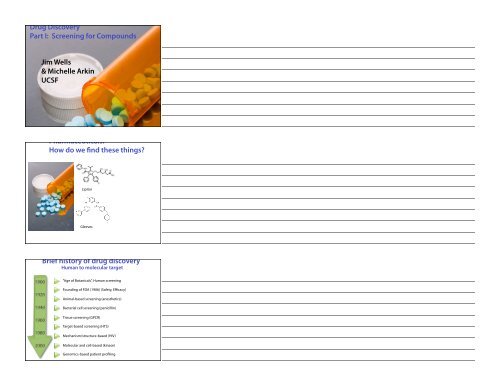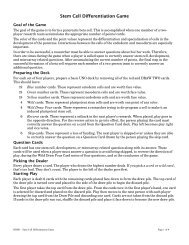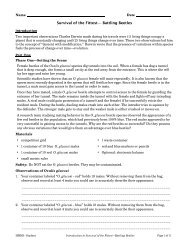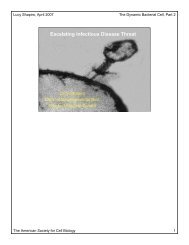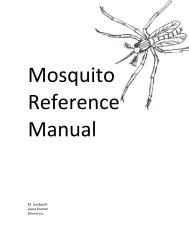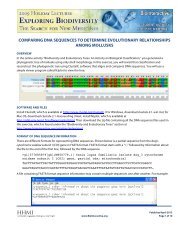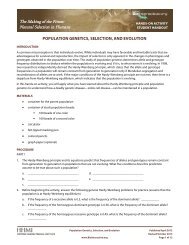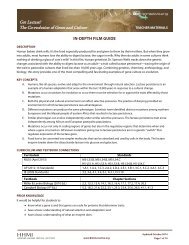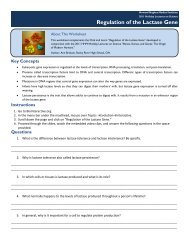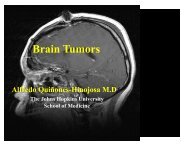Drug Discovery Part I: Screening for Compounds Jim Wells ...
Drug Discovery Part I: Screening for Compounds Jim Wells ...
Drug Discovery Part I: Screening for Compounds Jim Wells ...
You also want an ePaper? Increase the reach of your titles
YUMPU automatically turns print PDFs into web optimized ePapers that Google loves.
<strong>Drug</strong> <strong>Discovery</strong><br />
<strong>Part</strong> I: <strong>Screening</strong> <strong>for</strong> <strong>Compounds</strong><br />
<strong>Jim</strong> <strong>Wells</strong><br />
& Michelle Arkin<br />
UCSF<br />
Pharmaceuticals:<br />
How do we �nd these things?<br />
Lipitor<br />
Gleevec<br />
Brief history of drug discovery<br />
Human to molecular target<br />
“Age of Botanicals”, Human screening<br />
Founding of FDA (1906) (Safety, Efficacy)<br />
Animal-based screening (anesthetics)<br />
Bacterial cell screening (penicillin)<br />
Tissue screening (GPCR)<br />
Target-based screening (HTS)<br />
Mechanism/structure-based (HIV)<br />
Molecular and cell-based (kinase)<br />
Genomics-based patient pro�ling
Modern drug discovery: target to human<br />
Classes of <strong>Drug</strong> Molecules<br />
•Small organic molecules (10,000 MW, injectable)<br />
•Vaccines<br />
9 steps from target to pill<br />
Cell<br />
Protein<br />
Animal efficacy<br />
Animal Tox<br />
Human Safety<br />
Efficacy<br />
Registration<br />
NDA �ling<br />
Disease target
Target ID: what’s causing disease<br />
Target validation:<br />
What’s causing the disease?<br />
Infectious agent or host imbalance?<br />
Molecular target leading to disease<br />
• Bacteria: �nd target not in humans<br />
• Host imbalance:<br />
Replace underactive protein (insulin)<br />
Inhibit overactive protein (kinase)<br />
The genome (genetic space) is huge<br />
and lots to search<br />
• ~20,000 human genes that<br />
code <strong>for</strong> proteins<br />
• Which one is causing the disease
Target validation:<br />
Is the target “druggable”?<br />
•Are there known small molecules that<br />
bind the target or a homolog?<br />
Gleevec binding to BCR-ABL<br />
•Does the target have a site that looks like it<br />
will bind a small molecule (cavity, energetic<br />
hot-spot)?<br />
Small molecules like certain targets<br />
Target % of sm drugs Affinity<br />
(-ΔG per<br />
C,N,O)<br />
GPCR 45 0.5-0.7 kcal<br />
Kinases 4 0.35-0.5 kcal<br />
Protease 2 0.25-0.4 kcal<br />
P-P targets 0
Goals <strong>for</strong> oral drugs (chemical properties,<br />
Lipinski Rules)<br />
• Low Molecular Weight (
Hit Identi�cation: getting on the board<br />
Ways to identify a hit<br />
• Start with a natural substrate and<br />
make drug-like<br />
• Start with someone else’s hit<br />
(“patent bust”)<br />
• Design a denovo hit by Structurebased<br />
Design<br />
• <strong>Screening</strong> (HTS or Fragment<br />
methods)<br />
You have to test A LOT of compounds<br />
to �nd a drug
Start with libraries of drug-like molecules<br />
Functional<br />
groups<br />
~ 500,000<br />
compounds<br />
How to handle that many compounds?<br />
• Miniaturization (1 – 100 uL)<br />
• Automation<br />
• Parallel pipetting<br />
• Robotics<br />
• Plate readers<br />
Demo here<br />
• freezers<br />
• Demo liquid handler<br />
• Demo plates
Assay <strong>for</strong>mats: Biochemical<br />
• Use a puri�ed protein and an<br />
activity you can visualize<br />
substrate<br />
• Use when<br />
enzyme<br />
enzyme<br />
• You know what protein you<br />
want to inhibit<br />
• You can express and purify the<br />
protein<br />
• Selectivity among similar<br />
proteins is important<br />
Assay <strong>for</strong>mats: Cell-based<br />
• Screen in whole cells when<br />
• Molecular target known,<br />
but not isolable from cell<br />
• Goal is to alter a cellular<br />
phenotype<br />
• Pathway is known, best<br />
target is not known<br />
Assay <strong>for</strong>mats: Cell-based<br />
• Results read out by<br />
• Whole well<br />
�uorescence/<br />
luminescence<br />
• Cell-by-cell properties
Demo<br />
• Biochemical assays<br />
- Light-box fluorophore<br />
High-content cells screens:<br />
Quantitative microscopy<br />
• Demo<br />
High-content screens:<br />
Quantitative microscopy
% inhibition<br />
Assay quality and Hit selection<br />
Next Steps?<br />
• Retest<br />
• Determine mechanism<br />
• Optimize!<br />
compound #<br />
A hit is just the �rst step to discovering a<br />
drug<br />
Demo<br />
• Chemist in a hood
Introduction to <strong>Drug</strong> <strong>Discovery</strong><br />
Thanks to Kate Augustyn, Steven Chen, and<br />
Kenny Ang<br />
References<br />
High-throughput screening assays <strong>for</strong> the identi�cation of<br />
chemical probes. Inglese J, et al. Nat Chem Biol. 2007 Aug;<br />
3(8):466-79<br />
Small-molecule inhibitors of protein-protein interactions:<br />
progressing towards the dream. Arkin MR, <strong>Wells</strong> JA. Nat<br />
Rev <strong>Drug</strong> Discov. 2004 Apr;3(4):301-17.<br />
The development of imatinib as a therapeutic agent <strong>for</strong><br />
chronic myeloid leukemia. Deininger M, Buchdunger E,<br />
Druker BJ. Blood. 2005 Apr 1;105(7):2640-53<br />
Making better drugs: Decision gates in non-clinical drug<br />
development. Pritchard JF, Jurima-Romet M, Reimer ML,<br />
Mortimer E, Rolfe B, Cayen MN. Nat Rev <strong>Drug</strong> Discov. 2003<br />
Jul;2(7):542-53<br />
<strong>Drug</strong> <strong>Discovery</strong><br />
<strong>Part</strong> I: <strong>Screening</strong> <strong>for</strong> <strong>Compounds</strong><br />
Thanks to<br />
Kate Augustyn<br />
Steven Chen<br />
Kenny Ang


